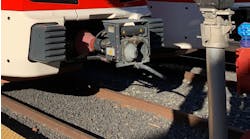Under the umbrella of the Mid-Region Council of Governments, the Rio Metro Regional Transit District has different opportunities to apply for a variety of grants for different programs. Looking at an opportunity to apply for a veterans’ transportation initiative, it was the graphic designer that stepped up to take the lead.
RTD’s graphic designer Michael Jiron heard about the project “on the other side of the cubicle” and wanted to get involved. The first thing was branding; he said it was important for the fund, the program, to have a brand.
The grant from the Federal Transit Administration (FTA) mandated two very specific things: Connect veteran agencies and transportation opportunities and create infrastructure for a one-click/one-call center. “We decided to do a one-click center because we had all the infrastructure,” said Jiron.
They put in the new phone system, a new email server for hosting and started moving down the road on the project. They had a White House roundtable, Jiron said, where Peter Roghoff from the FTA came and they asked him about future funding. “We were about 25 percent in to project planning,” Jiron said. “What are we going to do for longevity?
“Nope, it’s bankrupt were his words,” said Jiron. “There’s no more funding so what are we going to do with this thing?”
Call Center Creation
What they did next was to get together some cover partners. Jiron said, “This is where it really gets cool.
“We knew for longevity of this thing we were going to have to find staffing. If we’re going ot have a website, there has to be a call center because if someone has questions, you disenfranchise a group,” he explained. With downtime during the mid part of the commuting day, they looked at their call center to answer questions and field calls. They were concerned about potential overflow that they wouldn’t be able to handle so they worked with the Department of Workforce Solutions.
They looked at setting up a work-study site using veterans that are high in their degree plan to come in and answer calls, work on the database for the backend of the website and work with those calls. Jiron said, “That veteran who was isolated, trying to get transit, they’re not as isolated because they’re connected with a human. They’re talking to someone, they feel safe … it’s all coming together.”
This was done without spending any money. Those veterans are getting their GI bill to pay for it, MRCOG was just providing a room. Jiron said, “Granted the funding from the grant paid for all the capital assets, but our partnerships were making it work.”
He said MRCOG was providing him for project management design and keeping it in-house was able to save a lot of money.
Project Longevity
“The website has all of these pieces, the work-study program and then the call center, all of those pieces; it became this amazing product,” said Jiron.
He was continually looking at the longevity of this and how it could be a conduit for more things. “Why spend $400,000 and get everybody involved to just send them away after they come here on one visit,” he said. “I had a conversation with NMDVS [New Mexico Department of Veteran Services]. I was really looking for a piece of the website because I want to divide it into two things: the physical needs and social needs.”
They were looking at a leadership task force where they would develop community leaders and bring veterans in and use a template to work in their community building swingsets or filling potholes, working on cars, building gardens, those types of things. It was helpful and therapeutic and would help them be less isolated.
“That person has their leg fixed, well that’s not enough,” Jiron said. “They can go to the store, they still haven’t made a personal relationship, which is the key to get them out of isolation. Now we have that third part.”
NMDV had been working at establishing this type of product for several years and when they saw it, asked what MRCOG needed. And Jiron said: money, staffing and longevity – how do we keep this going? The first part was that NMDV put it on its legislative priorities list and MRCOG put it on its legislative priorities list so the more lists it gets on, when that session comes up then it will be able to get more funding.
Jiron then thought, why not “shoot for the moon.”
“I was looking at their website and I said, what if we create this $400,000 product and we give it to you for free. We give you this.” He continued, “We brand your agency and you take this as a way to re-interface with New Mexico.
“They just loved that idea,” he stated. “All of that infrastructure we had put together is becoming the new brand of NMDV and now this project is going to have longevity.”
The website branding was to create patriotism, communication and a spot on the map. There are also a lot of ADA pieces built in so you can see it very clearly, the large type and yet it still looks very current in design. The list of providers that are within the database are being vetted by the veterans helping enter the backend data. “They put things in the database themselves because they are using these resources,” Jiron said. “We end up with a database that’s solid.”
The website is still in the development phase and will be handed over to NMDVS in about June.
The Transportation Piece
With a solid plan in place to keep this project going, the next step was what to do between now and then, when NMDV releases the website. Jiron said, “We’ve got this website, we’ve got partners, people are excited about what we are doing. What do we do in the interim?”
Rio Metro had wanted to do a veteran pass. They started talking to others that were doing that type of program and looked at the numbers. They looked at the number of people that could qualify, figured about 10-13 percent of that total would use it so it was a low risk factor. “It wouldn’t affect the bottom line so much; the risk was relatively low. So we said let’s go ahead and do it,” said Jiron.
Jay Faught, marketing director for Rio Metro said they also saw it as a way to increase ridership. With new riders being able to ride for free, they’re probably not going to ride alone; they’re going to bring somebody with them.
Jiron said the pass allowed Rio Metro to interface with the public on this project they’ve been working on. “We have something to show for our work.” He added that with the partnerships between Rio Metro and other transit providers, with the Rio Metro pass they can get on most any other system in the region for free.
They created mobile ID machine units, similar to getting your driver’s license, so that it can’t be faked. Jiron said it protects the program and also makes people feel like they’re getting something of substantial value. They take the mobile units out to various events, such as the Hiring Our Heroes job fair. The unit sets up in about 10 minutes and they’re ready to start making passes.
Another important step for this was partnering with the New Mexico VA. Jiron said the VA is a federally funded organization and they don’t let anyone advertise there. So they went in and talked to them about the possibility of Rio Metro going in during one of the events. “We’re not trying to sell them tickets, this doesn’t benefit us,” he said.
They went to a health fair at the VA and had almost 500 sign up that day.
Jiron said it was important to partner with the VA because veterans need a VA card to get the pass. They were able to take a kiosk to the VA, the VA stores it and Rio Metro goes in twice a month to distribute cards. The kiosk is front and center by the benefits department window and they’re even on video boards, in printed material and have an online presence with the VA.
While Rio Metro’s part in the grant will end in about 8 months, the pass will likely remain Jiron and Faught said. “We’re calling this a pilot program right now,” Faught explained. “It’s an annual pass that will expire on December 31. We’re evaluate that later this year, look at our ridership, all those kinds of things.
“If we want to continue that, how do we want to do that? I don’t see it going away, but we want to be sure we have all the data.”
Currently Rio Metro has handed out approximately 2,100 passes.


